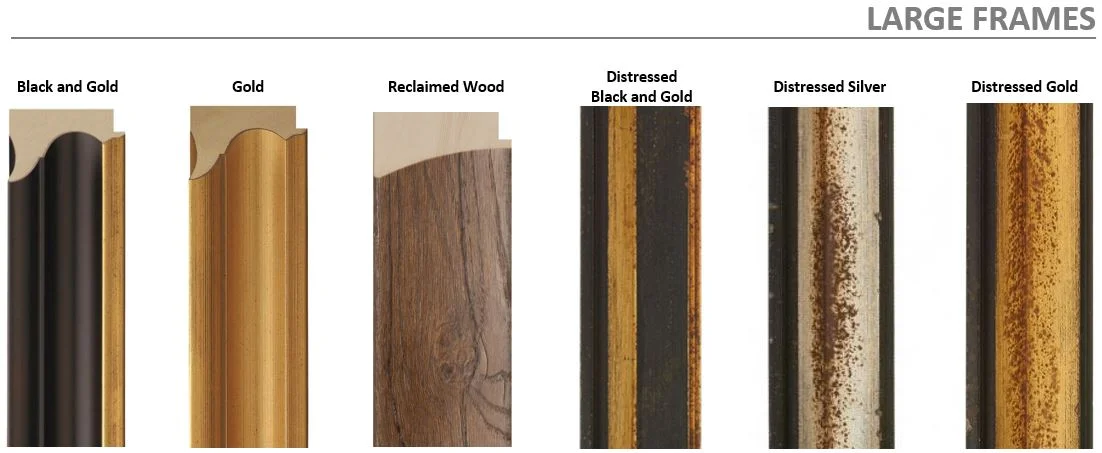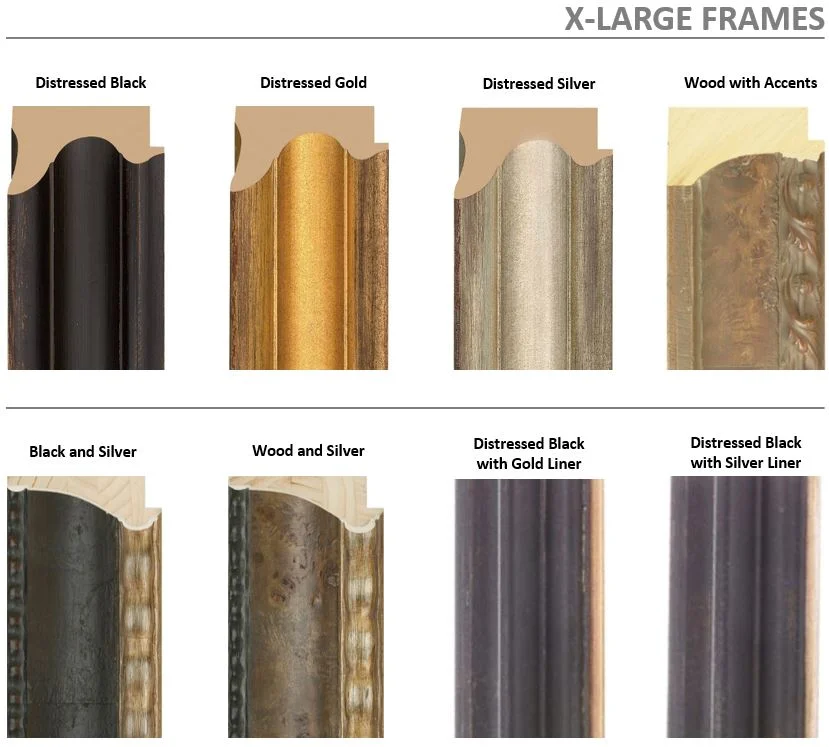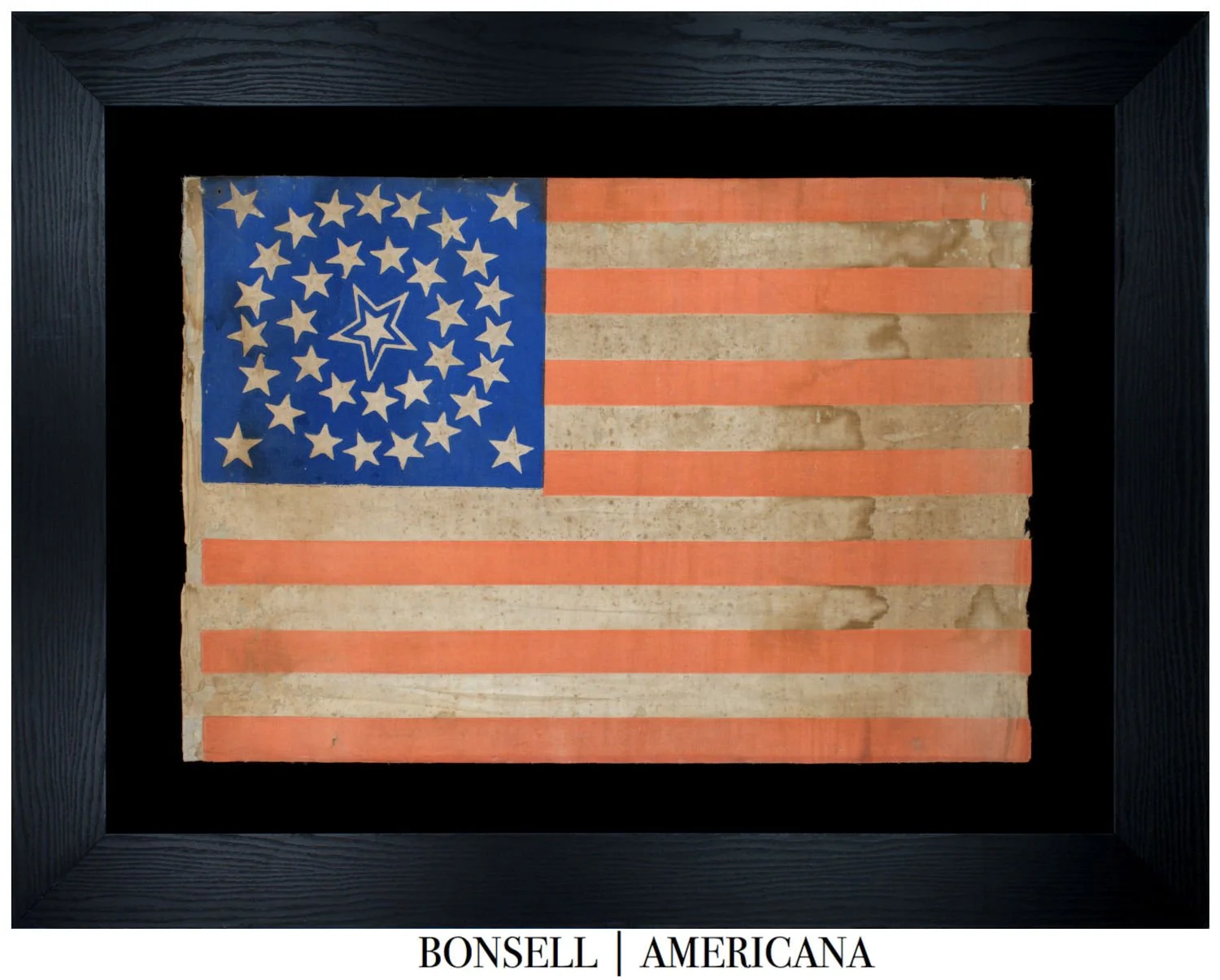Large Scale 34 Star Antique Flag | 32 Original Stars and 2 Additional Stars | Kansas Statehood | Circa 1858-1863
Large Scale 34 Star Antique Flag | 32 Original Stars and 2 Additional Stars | Kansas Statehood | Circa 1858-1863
Price: Call 618-553-2291, or email info@bonsellamericana.com
Frame Size (H x L): 54.75” x 94.5”
Flag Size (H x L): 42” x 81.5”
Offered is a thirty-four star antique flag. The canton of this flag is made of wool, and was made by a process known as press dyeing. This first press dyeing patent issued in 1849, and several other patents issued in the 19th century for similar, improved processes. The method described in the 1849 patent included using a dye vat in combination with a dyeing frame. The dyeing frame was made, so as to prevent the dye from penetrating portions of the flag that did not need any color (e.g., the stars). Press dyeing never gained widespread use, as it tended to result in minor printing blemishes.
The stars of this flag are arranged in an 8-1-8-8-1-8 pattern. The rows with eight stars were created using the above described press dyeing process. In contrast, the single stars in the second and fifth rows were handsewn into place. Both of the handsewn stars were placed using a single-applique technique. With this technique, the canton is cut-away from behind each star and then hemmed. And by doing this, the single piece of material used for each star can be seen on both sides of the flag. In the case of this flag, this technique was likely used to conserve material, as only a single star was needed (instead of one star on one side and a second star on the other side).
The single star in the fifth row faces downwards, meaning that a single point of the star is facing downwards and two points are facing upwards. Why stars are placed upside down on antique flags is unclear. In at least some cases, flag makers probably did not consider any orientation of the stars to be “upwards” or “downwards,” and simply just placed them whichever they felt was correct or interesting.
There are at least two theories behind why this flag has thirty-two printed stars and two handsewn stars. The first theory is that the commercial manufacturer intended on making this a thirty-four star flag from the start, and that similar thirty-two star flags that have surfaced were mistakenly distributed surplus flags. The second theory is that the commercial manufacturer intended on distributing this flag as a thirty-two star flag. With this theory, the thirty-two star flag went unsold and became obsolete, forcing the commercial manufacturer to add two additional stars to match the number states in the quickly growing Union. We believe that the second theory is the most logical, given that we have encountered roughly equal numbers of these flags in the thirty-two and thirty-four star variations (though both are quite rare).
The commercial manufacturer of this flag may have been Annin Flagmakers. The late Howard Madaus, one of America’s foremost flag and arms historians, was the first to make this assertion. The Annin brothers began making flags in 1820, and they formally founded Annin Flagmakers, in 1847, in New York City. Because this flag was commercially made (i.e., based on several still surviving examples) and because Annin Flagmakers was—and still is—a leading flag manufacturer, Madaus’s suggestion that Annin Flagmakers made this flag is a logical one.
The stripe field includes an upper section and a lower section. The two sections are handsewn together, and the canton is handsewn thereto. The red stripes were woven into the fabric, using a red horizontal warp and a white vertical weft. Because of this combination, the red stripes are an unusual milky red. The hoist strip is made of heavy cotton twill and includes handsewn grommets. The hoist strip further includes a pencil inscription, but it is indecipherable. It was likely the name of the owner.
This flag is elongated in its proportions. The First Flag Act of 1777 did not specify the dimensions or proportions of the American flag. And such freedom extended up until 1912, the time at which President Taft issued Executive Order 1556, establishing official proportions.
The thirty-four star flag represents the inclusion of Kansas to the Union. Kansas was admitted on January 29th, 1861, and this flag became official on July 4th, 1861. President Lincoln served, and the Civil War was fought, under this star count. Many thirty-four star flags predate the first shots of the Civil War in 1861, as flag makers began producing them upon the admission of the Kansas, instead of the time at which the flag was officially admitted to the Union later in the same year. The thirty-four star flag was official until July 4th 1863, the time at which the thirty-five star flag became official and began to represent the inclusion of West Virginia in the Union.
Thirty-four and thirty-five star flags were the official flags for the majority of the Civil War, and for this reason, both are extremely collectible. Flags associated with this time period (1861-1865) and earlier are among the rarest and most desirable of all US flags. Prior to the Civil War, Americans did not typically display flags for patriotic purposes. In fact, even the military did not regularly use the flag, as it was not until 1834 that the army field artillery was permitted to carry the traditional US flag, and not until 1841 that regiments carried it. Instead, most flags prior to the Civil War were used to mark ships, and were massive in scale so as to be seen from large distances.
Conservation Process: This flag was hand sewn to silk organza, and both were hand sewn to cotton fabric. The silk organza provides a strong layer of protection and a professional appearance. The flag, the silk organza, and the cotton fabric were then hand sewn to a mounting board. To prevent the black dye in the cotton fabric from seeping into the flag, it was first washed in a standard wash and then in a dye setting wash. The flag is positioned behind Conservation Clear Acrylic (standard) or behind Optium Museum Acrylic (per request).
Frame: This offering is in a special edition X-Large Frame. However, it can be reframed and would look great using any one of our standard Large or X-Large Frames, which are shown in the final two images. The pricing associated with the different framing options may vary. Reframing of an offering may delay shipment by up to two weeks.
Condition Report: This flag exhibits use and good colors. It includes some minor holes and light fraying. This flag displays well and has the Civil War era appearance that our clients desire.
Collectability Level: The Best – Perfect for Advanced Collectors
Date of Origin: 1858-1863
Number of Stars: 34
Associated War: The Civil War (1861-1865)
Associated State: Kansas












